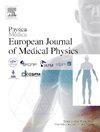与新型双源 CT 相比,使用光子计数 CT 可减少胸部 CT 的剂量并提高图像质量。
IF 3.3
3区 医学
Q1 RADIOLOGY, NUCLEAR MEDICINE & MEDICAL IMAGING
Physica Medica-European Journal of Medical Physics
Pub Date : 2024-11-01
DOI:10.1016/j.ejmp.2024.104844
引用次数: 0
摘要
目的:比较光子计数 CT(PCCT)与双源 CT(DSCT)在胸部 CT 图像中降低剂量和提高质量的潜力:在 5 个剂量水平(9.5/7.5/6.0/2.5/0.4 mGy)下使用 DSCT 和 PCCT 对模型进行采集。通过计算噪声功率谱(NPS)和基于任务的传递函数(TTF),分别评估噪声大小、噪声纹理(fav)和空间分辨率(f50)。计算出的可探测性指数(d')模拟了对两种胸部病变的探测:实性下肺结节(SPN)和高对比度肺结节(HCN)。两名放射科医生在一个拟人模型上对胸部图像的质量进行了主观评估:结果:在所有剂量水平下,PCCT 的噪声幅度都明显低于 DSCT(-44.7 ± 3.0 %;p av;-6.2 ± 0.5 %;p 50),在碘插入剂量为 9.5 至 6 mGy 时,DSCT 的噪声值明显高于 PCCT(p 结论:PCCT 的噪声幅度和肺结节的可探测性都高于 DSCT(-44.7 ± 3.0 %;p av;-6.2 ± 0.5 %;p 50):PCCT 的噪声大小和胸部病变的可探测性均优于 DSCT。PCCT 在为接受胸部 CT 检查的患者减少剂量方面具有巨大潜力。本文章由计算机程序翻译,如有差异,请以英文原文为准。
Potential dose reduction and image quality improvement in chest CT with a photon-counting CT compared to a new dual-source CT
Purpose
To compare potential dose reduction and quality improvement in chest CT images with Photon-Counting CT (PCCT) versus a Dual-Source CT (DSCT).
Methods
Acquisitions on phantoms were performed on a DSCT and a PCCT at 5 dose levels (9.5/7.5/6.0/2.5/0.4 mGy). Noise power spectrum (NPS) and task-based transfer function (TTF) were calculated to assess noise magnitude and noise texture (fav) and spatial resolution (f50), respectively. Computed detectability indexes (d′) modelled the detection of 2 chest lesions: subsolid pulmonary nodules (SPN) and high-contrast pulmonary nodules (HCN). Two radiologists subjectively assessed the quality of chest images on an anthropomorphic phantom.
Results
For all dose levels, noise magnitude was significantly lower with PCCT than with DSCT (−44.7 ± 3.0 %; p < 0.05). Identical outcomes were found for noise texture (fav; −6.2 ± 0.5 %; p < 0.05). f50 values were significantly higher with DSCT than with PCCT from 9.5 to 6 mGy for iodine insert (p < 0.05) and from 7.5 to 2.5 mGy for air insert (p < 0.05), but similar for both inserts at other dose levels. For all dose levels, d’ values were significantly higher with PCCT than DSCT (71.9 ± 5.4 % for HCN and 65.6 ± 13.5 % for SPN). From 9.5 to 2.5 mGy, the potential dose reduction was −59.0 ± 3.9 % for both lesions with PCCT compared to DSCT. Chest images were rated satisfactory for clinical use by the radiologists with both CTs for all dose levels, except at 0.4 mGy.
Conclusion
Noise magnitude and detectability of chest lesions were better with PCCT than with the DSCT. PCCT may offer great potential for dose reduction in patients undergoing chest CT examinations.
求助全文
通过发布文献求助,成功后即可免费获取论文全文。
去求助
来源期刊
CiteScore
6.80
自引率
14.70%
发文量
493
审稿时长
78 days
期刊介绍:
Physica Medica, European Journal of Medical Physics, publishing with Elsevier from 2007, provides an international forum for research and reviews on the following main topics:
Medical Imaging
Radiation Therapy
Radiation Protection
Measuring Systems and Signal Processing
Education and training in Medical Physics
Professional issues in Medical Physics.

 求助内容:
求助内容: 应助结果提醒方式:
应助结果提醒方式:


